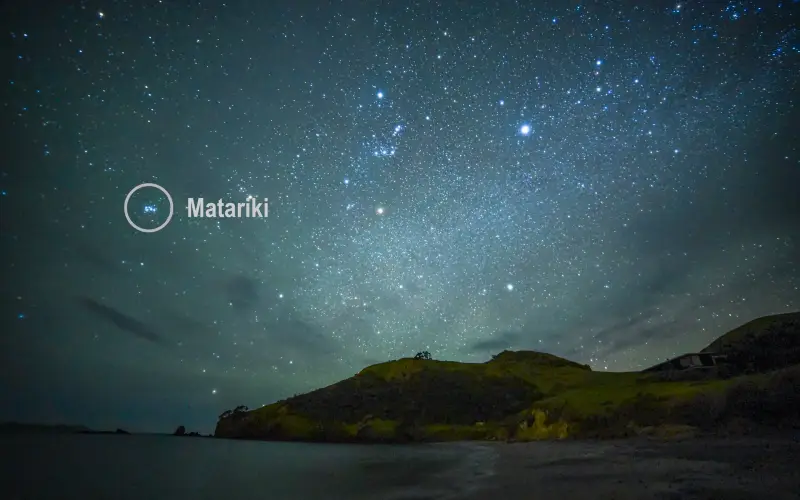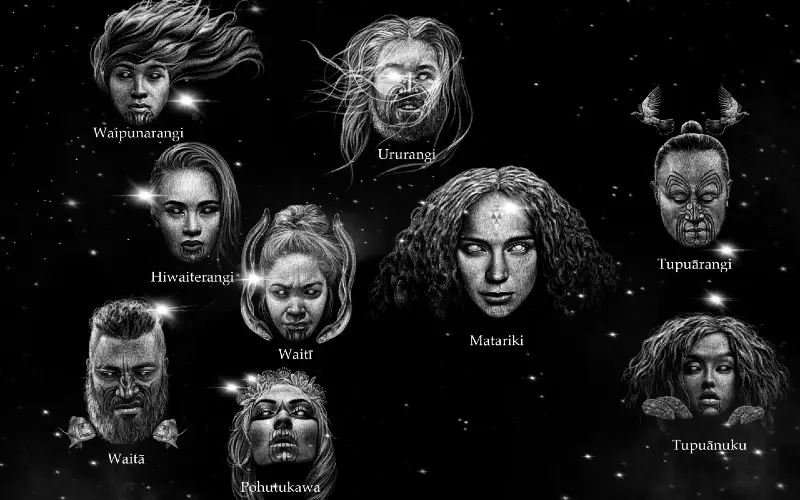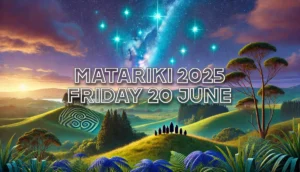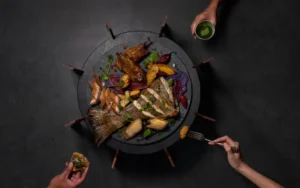Matariki
Welcome to Matariki.co.nz, your comprehensive guide to celebrating Matariki, the Māori New Year, in New Zealand. As the stars of the Matariki cluster rise in the winter sky, they signal a time of remembrance, reflection, and renewal across Aotearoa. Matariki is a special period that connects us to the land, the sky, and each other, through a series of events, traditions, and celebrations that are deeply rooted in Māori culture.
Here, we aim to bring the essence of Matariki to life for all New Zealanders and visitors from around the globe. Whether you’re looking to learn about the significance of the Matariki stars, find local events where you can immerse yourself in the festivities, or explore ways to honor this important time with your family and community, Matariki.co.nz is your gateway to it all.
Key Sections:
Matariki History and Cultural Significance
Matariki has a rich history and cultural significance in New Zealand, particularly within Māori communities. The celebration is deeply rooted in the country’s indigenous culture and has been passed down through generations. The name “Matariki” means “tiny eyes” or “eyes of god” in Māori and refers to the seven bright stars that make up the Pleiades cluster.
Traditionally, Matariki was used as a way to mark the start of the Māori New Year, which occurs with the rise of the star cluster. It was a time for harvesting and preparing the land for the coming year, as well as a time for honoring ancestors and engaging in cultural practices such as waiata (song), haka (dance), and kai (food).
Today, Matariki has become an increasingly popular and widely celebrated event in New Zealand. It is a time for all New Zealanders to come together and recognize the importance of Māori culture and its contributions to the country’s identity. Many events and activities are organized around the country to celebrate Matariki, including art exhibitions, concerts, food festivals, and cultural workshops.
One of the key features of Matariki is the concept of whakapapa, which refers to the interconnectedness of all living things and the importance of family and community. It is a time for reflecting on the past year and setting intentions for the future, with a focus on personal growth and community wellbeing. Many people take this time to engage in acts of service, volunteerism, and giving back to their communities.
The Matariki public holiday, which was established in 2022, is a reflection of the growing recognition and importance of Matariki in New Zealand culture. It provides an opportunity for all New Zealanders to take part in the festivities and learn more about Māori culture and traditions.
As Matariki continues to grow in popularity and significance, it has become an important part of New Zealand’s national identity and cultural heritage. The festival is a time for all New Zealanders to come together and celebrate the rich and diverse culture of the country, and to reflect on the interconnectedness of all things.
Matariki 2025 – Friday, 20 June: Reflect, Celebrate, Reconnect
Matariki 2025 marks a special time in Aotearoa — a season for remembrance, renewal, and togetherness. This year, the Matariki public holiday is officially set for Friday, 27 June, with celebrations running from 7 June to 13 July. The theme for 2025 is “Matariki mā Puanga” — a celebration of inclusion, embracing diversity, and coming together as one.
Rooted in te ao Māori, Matariki is a time to reflect on the past, honour those we have lost, and reconnect with whānau and whenua. This year’s theme highlights the importance of unity and collective celebration — welcoming all communities to participate, learn, and share in the meaning of Matariki. It reminds us that although we may come from different walks of life, we are all part of a shared story under the rising stars.
Across the country, communities are embracing Matariki 2025 through inclusive and diverse events — from dawn ceremonies and kapa haka performances to multicultural storytelling, shared kai, and whānau-friendly activities. Whether you’re in Auckland for Te Hui Ahurei o Matariki, attending the Puaka Matariki Festival in Dunedin, or visiting a local community gathering, there’s a place for everyone.
Matariki mā Puanga also encourages intergenerational connection and learning. Tamariki are exploring Matariki through school workshops, while kaumātua share stories, traditions, and wisdom with younger generations. These celebrations are not just cultural events — they are opportunities to build bridges, strengthen relationships, and affirm our shared values of aroha, kotahitanga (unity), and manaakitanga (hospitality).
As the stars of Matariki rise once again, they invite us to celebrate our differences, strengthen our bonds, and move forward together. The Matariki 2025 date is more than a holiday — it’s a call to unite in spirit, honour our heritage, and dream of a future shaped by collective hope, understanding, and respect.
Learn more about Matariki 2025 here

Matariki Resources: Celebrate the New Year with Traditional Foods, Events, and Cultural Guides
We believe that celebrating Matariki is an important way to connect with New Zealand’s unique cultural heritage and deepen our understanding of the values and beliefs of the Māori people. That’s why we are committed to providing a wealth of resources and information to help you make the most of this special time of year.
If you’re looking for ways to get involved in Matariki celebrations, we have compiled a comprehensive list of events and activities taking place across the country. From traditional waiata (songs) and kapa haka (performances) to contemporary art exhibitions and food festivals, there is something for everyone to enjoy. Our events calendar is regularly updated to ensure you don’t miss out on any Matariki happenings in your local area.
We also offer a range of recipes for traditional Matariki foods, such as kūmara (sweet potato) and rewana (sourdough bread). These recipes have been passed down through generations of Māori families and are an important part of the Matariki celebration. Whether you’re a seasoned cook or a beginner in the kitchen, our recipes are easy to follow and will help you create delicious Matariki dishes to share with family and friends.
In addition to our events and recipes, we provide cultural guides, Free Matariki Images and educational resources to help you learn more about the significance of Matariki in New Zealand culture. Our guides cover a range of topics, from the history of Matariki and its connection to the land, to the spiritual and cultural meanings of the seven stars in the Pleiades cluster. We also offer resources for teachers and educators, including lesson plans and activities for students of all ages.
At Matariki.co.nz, our goal is to make it easy for you to celebrate and learn about Matariki in a meaningful and authentic way. We are constantly updating our resources and adding new content, so be sure to check back regularly for the latest information and inspiration.

Discover the Best Matariki Events and Activities Across New Zealand
Matariki is a time of celebration and renewal, and there are many events and activities to participate in throughout New Zealand. At Matariki.co.nz, we have compiled a comprehensive list of these events and activities, so you can easily find something that suits your interests.
One popular event that takes place during Matariki is the Matariki Festival in Auckland. This festival features a variety of events, including music and dance performances, art exhibits, and traditional Māori ceremonies. The festival typically runs for several weeks and draws visitors from all over New Zealand.
Other popular events during Matariki include hāngi feasts, which are traditional Māori meals cooked in an earth oven. These feasts often take place at marae (Māori meeting houses) and are a great way to experience Māori culture and cuisine.
For those who enjoy the outdoors, there are also many Matariki-themed hikes and walks available throughout the country. These hikes often take place at night, so participants can enjoy the stars and the beautiful winter landscape.
In addition to these events, there are also many other activities available during Matariki. For example, many schools and community groups hold Matariki-themed workshops, where participants can learn about traditional Māori arts and crafts.
No matter what your interests are, there is sure to be a Matariki event or activity that you will enjoy. Be sure to check out our comprehensive list of events and activities to find out what’s happening near you. And don’t forget to check back often, as we update our list regularly to include the latest events and activities.

Delicious Traditional Māori Recipes for Your Matariki Celebration: Try Our Recipes Today
Matariki is a time for feasting, and traditional Māori foods are an essential part of the celebration. The recipes we have compiled at Matariki.co.nz are not only delicious, but they also hold cultural significance.
Kumara, or sweet potato, is a staple food in Māori cuisine, and kumara soup is a popular dish during Matariki. Made with kumara, onion, garlic, and chicken stock, it is a warming and nutritious dish perfect for winter. Rewana bread is another traditional Māori food that has been passed down through generations. This sourdough bread is made using a starter dough called rewana, which gives it a unique tangy flavor. Finally, boil-up is a hearty stew made with pork, potatoes, kumara, and other vegetables. It is a popular dish during Matariki, and it is traditionally cooked in a large pot over an open fire.
These recipes are not only a delicious way to celebrate Matariki but also an opportunity to connect with Māori culture and traditions. By preparing and sharing these dishes with family and friends, we can honor the significance of Matariki and its importance in New Zealand culture.
Discover the Significance of Matariki with Our Cultural Guides
Our cultural guides also explore the various customs and traditions associated with Matariki, including the lighting of the Matariki star, the role of kai (food) in Māori culture, and the importance of whānau (family) in Matariki celebrations. By learning about these cultural practices, you can gain a deeper understanding and appreciation for Matariki and its significance in New Zealand culture.
We also provide educational resources for schools and educators to incorporate Matariki into their curriculum. These resources include lesson plans, activities, and educational videos to help students learn about Matariki in a fun and engaging way.
Additionally, our website offers a directory of Māori cultural centers and tourism operators where you can experience Māori culture firsthand, including traditional Māori performances, waka (canoe) tours, and marae visits. By supporting these businesses, you can also contribute to the preservation and promotion of Māori culture.

Explore Our Matariki Educational Resources for Children and Students
At Matariki.co.nz, we believe in the power of education and are committed to providing teachers, parents, and students with resources to help them learn about the significance of Matariki. Our educational resources are designed to be engaging and informative, while also aligning with the New Zealand curriculum.
Our lesson plans cover a range of topics related to Matariki, including the history and cultural significance of the festival. We provide activities and worksheets that are suitable for students of different ages and learning levels, making it easy for teachers to integrate Matariki into their classroom curriculum.
Our resources also include suggestions for arts and crafts projects that students can create to celebrate Matariki. These projects allow students to explore their creativity while learning about the cultural significance of the festival.
We understand that learning about Matariki can be a fun and interactive experience, which is why we offer a range of educational resources that are designed to engage and inspire students. Our resources are constantly updated to ensure that they remain relevant and effective, making it easy for teachers to incorporate Matariki into their teaching plans.
The Nine Stars of Matariki
| Māori | Greek | Gender | Provenance |
|---|---|---|---|
| Matariki | Alcyone | Female | Well-being and health |
| Tupu-ā-rangi | Atlas | Male | Food that comes from above |
| Tupu-ā-nuku | Pleione | Female | Food that grows in the soil |
| Ururangi | Merope | Male | The winds |
| Waipunā-ā-rangi | Electra | Female | Rainwater |
| Hiwa-i-te-rangi | Celaeno | Female | Growth and prosperity |
| Waitī | Maia | Female | Fresh water |
| Waitā | Taygeta | Male | The ocean |
| Pōhutukawa | Sterope | Female | The deceased |
Matariki (Alcyone): Matariki, often associated with Alcyone in Greek mythology, takes a central role in the Matariki star cluster. In Māori culture, Matariki represents the essence of well-being and health. This guiding star embodies the importance of good health and the overall state of well-being for individuals and communities. It serves as a reminder of the need to nurture both physical and mental health to lead a fulfilling life. Matariki’s presence during the Māori New Year signifies a fresh start and an opportunity for personal growth and rejuvenation.
Tupu-ā-rangi (Atlas): Corresponding to Atlas in Greek mythology, Tupu-ā-rangi carries a male association and symbolizes food that descends from the heavens. This star highlights the vital role of celestial blessings in agriculture and food production. It acknowledges the significance of rain, sunlight, and other celestial factors in nurturing crops and sustenance. Tupu-ā-rangi reminds us of the interconnectedness of the Earth and the cosmos in the cycle of life.
Tupu-ā-nuku (Pleione): Like Pleione in Greek mythology, Tupu-ā-nuku is embodied as a female star and signifies food that originates from the Earth’s soil. This star emphasizes the importance of agriculture and the fertility of the land. It represents the nurturing and cultivation of crops from the earth, connecting communities to the very essence of sustenance and the Earth’s abundance.
Ururangi (Merope): Ururangi, with its male association, is associated with the winds. This star, akin to Merope in Greek mythology, draws attention to the crucial role of wind patterns in shaping weather conditions and aiding navigation. The winds, as represented by Ururangi, have historically been instrumental in seafaring activities, emphasizing the significance of this star in maritime culture.
Waipunā-ā-rangi (Electra): Waipunā-ā-rangi, represented as a female star, embodies the essence of rainwater. This star underscores the importance of rain in sustaining life, nourishing the land, and providing fresh water sources. It symbolizes the life-giving properties of rain and its contribution to the overall well-being of ecosystems and communities.
Hiwa-i-te-rangi (Celaeno): Hiwa-i-te-rangi, a female star, signifies growth and prosperity. This star encourages individuals and communities to pursue their aspirations, nurture their potential, and work toward a prosperous future. It represents the optimism and hope associated with personal and collective growth during the Māori New Year.
Waitī (Maia): Waitī, also represented as a female star, is associated with fresh water sources. It serves as a reminder of the critical importance of clean and accessible water for sustenance, health, and overall well-being. Waitī embodies the significance of preserving and cherishing this precious resource.
Waitā (Taygeta): Waitā carries a male association and is linked to the ocean. Similar to Taygeta in Greek mythology, this star signifies the oceans’ vital role in the lives of Māori communities. It symbolizes the oceans’ abundance, resources, and the historical significance of marine environments in navigation and cultural practices.
Pōhutukawa (Sterope): Pōhutukawa, represented as a female star, is associated with the deceased and the spirits of ancestors. It holds a special place in the Māori New Year, serving as a time for remembrance and honoring those who have passed away. Pōhutukawa connects the living with their ancestors and emphasizes the importance of preserving cultural heritage and traditions.
These nine stars collectively form the Matariki star cluster, each with its unique significance and symbolism in Māori culture. Together, they create a celestial tapestry that reflects the interconnectedness of the Earth, the cosmos, and the rich heritage of the Māori people.
Discover the Magic of Matariki with Matariki.co.nz – Your Ultimate Resource for Celebrating Matariki in New Zealand
At Matariki.co.nz, we believe that everyone can take part in the celebrations of Matariki. Whether you are a Māori or non-Māori, a long-time New Zealand resident or a new visitor to our beautiful country, there is something for everyone to discover and enjoy during this time.
By exploring our website, you can deepen your knowledge and understanding of Matariki and its significance in New Zealand culture. From learning about the history of Matariki to discovering the different stars in the Pleiades cluster, you can delve into the rich cultural heritage of this celebration.
We also encourage you to participate in Matariki events and activities taking place throughout the country. By joining in the celebrations, you can experience firsthand the joy and spirit of Matariki, connect with others, and create meaningful memories with your family and friends.
So, we invite you to take a moment to explore our site and learn more about Matariki. We hope that our resources, events, and cultural guides will inspire you to join us in honoring this important tradition and celebrating the new year ahead.
What is Matariki and why is it significant?
Matariki marks the Māori New Year and is a significant event in the cultural calendar of New Zealand. It signifies the rising of the Matariki star cluster (also known as the Pleiades or the Seven Sisters) in the winter night sky, heralding a time of renewal and celebration for Māori people. Traditionally, Matariki was a time to remember those who had passed, celebrate the present, and plan for the future. It’s a period that connects New Zealanders to the land and the skies, reflecting on the cycle of life and nature.
The significance of Matariki extends beyond its astronomical aspects; it’s a time for communities to come together, share in feasts, engage in song and dance, and participate in cultural activities that reinforce bonds and cultural identity. Matariki celebrations are an opportunity to learn about and honor the traditions and stories of Māori culture, which are integral to New Zealand’s national identity. The observance of Matariki has seen a resurgence in recent years, with its importance increasingly recognized in the wider New Zealand society, symbolizing unity, reflection, and hope for the future.
How is Matariki celebrated across New Zealand?
Matariki celebrations across New Zealand are as diverse as the communities that observe them. The festivities are a blend of traditional and contemporary practices, often starting with the sighting of the Matariki star cluster. Communities might gather for dawn ceremonies to welcome the new year with karakia (prayers) and waiata (songs). These gatherings are a time for reflection, remembering those who have passed, and looking forward to the year ahead.
Throughout the Matariki period, a variety of events are held, including cultural performances, art exhibitions, workshops, and lectures that educate and celebrate Māori heritage. Traditional foods play a significant role in Matariki celebrations, with hāngī (earth oven cooking) feasts being a common feature. Such gatherings are an expression of hospitality and generosity, essential values in Māori culture.
Environmental stewardship is another key aspect of Matariki, with communities engaging in tree planting and environmental clean-ups, symbolizing the care for the land that sustains life. Educational activities for children and youth are also prominent, aiming to pass on knowledge and practices to the next generation. These celebrations not only honor Māori traditions but also foster a sense of unity and belonging among all New Zealanders, encouraging respect and understanding across cultures.
What are the stars of Matariki and what do they represent?
The Matariki star cluster consists of nine visible stars, each holding special significance in Māori astronomy and cultural beliefs. These stars are seen as the celestial whānau (family) of Matariki, with each star representing different aspects of the environment and human life. They are:
Matariki – the mother of the other stars, associated with health and well-being.
Waitī – tied to freshwater bodies and the food sources within them.
Waitā – associated with the ocean and seafood.
Waipunarangi – connected to rain.
Tupuānuku – linked to food that grows in the ground.
Tupuārangi – linked to food that comes from the air, such as birds and fruits.
Ururangi – represents the winds.
Pōhutukawa – associated with those who have passed away, helping to remember and honor them.
Hiwa-i-te-rangi – the wishing star, associated with hopes and dreams for the coming year.
These stars guide the Māori in understanding the natural world and their place within it, influencing agricultural practices, fishing, and environmental awareness. The stories and teachings surrounding the Matariki stars are a rich part of New Zealand’s cultural heritage, offering insights into Māori cosmology and the interconnectedness of all life.
How can I participate in Matariki celebrations if I’m not Māori?
Participating in Matariki celebrations is a wonderful way for non-Māori to engage with and respect the indigenous culture of New Zealand. Many communities and organizations across the country host events that are open to the public, offering opportunities for everyone to learn about Māori traditions, values, and the significance of Matariki. Attending such events, whether they be cultural performances, art exhibitions, workshops, or lectures, can provide insights into Māori heritage and the importance of Matariki.
Volunteering for environmental activities or community projects during Matariki is another meaningful way to participate. Such initiatives often focus on sustainability and caring for the land, reflecting Māori principles of guardianship (kaitiakitanga) over nature.
Educating oneself about Matariki and Māori culture is also important. Many resources are available, including books, documentaries, and online articles, that can deepen understanding and appreciation for the celebrations. Engaging respectfully and with an open heart and mind will enrich your experience and contribute to the inclusive spirit of Matariki.
What is the future of Matariki celebrations in New Zealand?
The future of Matariki celebrations in New Zealand looks promising, with growing recognition of its importance to the country’s cultural identity and heritage. The recent move to make Matariki a public holiday is a significant step in acknowledging the cultural significance of the Māori New Year, offering an opportunity for all New Zealanders to celebrate together. This formal recognition is expected to increase awareness and participation in Matariki celebrations, further integrating Māori traditions into the national consciousness.
As understanding and appreciation for Matariki continue to grow, we can expect to see an expansion of events and activities that highlight Māori culture and traditions, fostering a more inclusive and multicultural society. Schools, community groups, and governmental organizations are increasingly incorporating Matariki into their calendars, promoting educational programs that teach the history and customs associated with the Māori New Year.
Moreover, the celebration of Matariki encourages discussions on broader issues such as environmental stewardship, sustainability, and community well-being, aligning with global conversations on these critical topics. As New Zealanders from all backgrounds come together to honor Matariki, the celebrations are likely to evolve, incorporating new traditions while respecting the ancient roots of this special time. This evolution will ensure that Matariki remains a vibrant and meaningful celebration for generations to come, reflecting the dynamic and diverse nature of New Zealand society.


